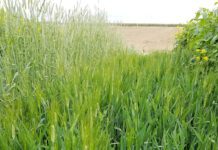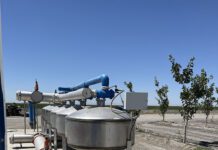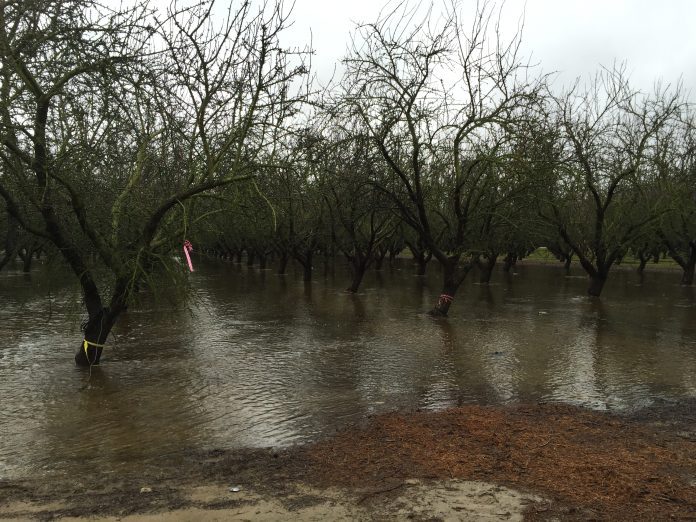
California and much of the west has seen the driest conditions in at least 1,200 years. While recent rains have improved the situation, California still isn’t out of the drought. Groundwater recharge still holds promise for mediating some of the impacts of drought on groundwater tables.
With interest in recharge surging given the recent rains, it’s a good opportunity to check in with one of the research pioneers in this practice to see what we know so far.
Helen Dahlke, associate professor of integrated hydrologic sciences with UC Davis, has done several years of research on groundwater recharge working primarily on the impact groundwater or winter recharge has on nitrate leaching and nitrogen cycling in soil, mainly in the root zone. The research was done on perennial crops, including nut crops and vineyards to look at the effects of extended flooding on plant response and yield in the following growing season.
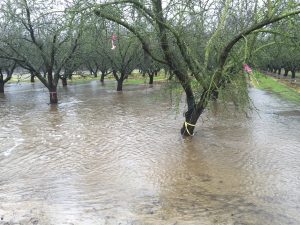
Recharging the Aquifer
The intent of on-farm recharge is to recharge the aquifer so that the water can be pumped out later. Current rainfall is producing natural recharge. The rain is falling onto the soil, and depending on where a farm is located, the soil could be clay or silt loam, or coarser-textured soil like sand. A certain amount of that rainfall would go into the soil and potentially move deeper past the root zone to the groundwater table.
“We think some soils, particularly the sandy ones, can definitely infiltrate a lot more water, and so this is why I think a combination of precipitation plus intentionally directing floodwaters onto the soil could really allow us to infiltrate a lot more water than what would naturally occur. And that definitely can help the groundwater aquifer underneath it,” Dahlke said.
To intentionally direct the floodwaters, growers would create dikes or levees to hold the water within a field or orchard. “We typically recommend putting berms around, maybe one- to two-foot-high earth mounds,” Dahlke said, adding this is something growers can do with equipment they have on the farm.
Most of Dahlke’s experiments were done between the end of February and early April, much later in the season when crops are typically coming out of dormancy. Fields were flooded for two and four weeks, time periods typical of recent flooding, Dahlke said.
“Any active growth requires oxygen. When you have standing water, often what happens is that the amount of air or oxygen that we have in the soil is going down quickly, which can create so-called hypoxic conditions. And the roots, besides taking up water and nutrients for a tree to grow, they also have to do gas exchange, which is called root respiration. So, when there is an actively growing tree or crop sitting in standing water, then that gas exchange can no longer happen and they can’t take up oxygen through the root system,” Dahlke said, and that often means the plant goes into metabolic stress and can die.
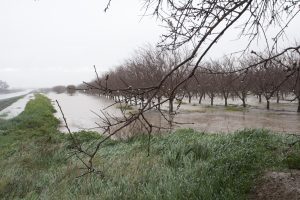
Nut Orchards
Dahlke was involved with pecan research and groundwater recharge several years ago with Ben King, a California pecan grower. King had a young pecan orchard sitting behind a levee and in a flood retention area. For months, only the crowns of the trees were above the water, and the water depth was about six to seven feet.
“This is really something not every crop can tolerate, but pecans are native to North America. You can actually see them growing wild along the Sacramento River, so they’re used to having wet feet for extended periods of time because flooding has occurred naturally in past centuries. They don’t seem to be impacted at all by the floodwater as long as they’re not completely submerged,” Dahlke said.
Dahlke hasn’t yet been able to research recharge on walnuts due in part to a lack of funding amid grower concerns. “I think maybe from a physiology perspective, as long as the trees are dormant, they probably can tolerate on-farm recharge quite well,” she said.
“I think the main reason walnut growers are shying away from doing on-farm recharge is the risk of the fungal disease Phytophthora, which can spread really quickly with floodwaters. Warm, moist temperatures are really ideal conditions for the fungus to spread, and once you have it in your orchard, it’s definitely hard to contain,” Dahlke said.
Walnuts are grown for fairly long periods of time compared to almonds that are typically 25 to 30 years. “So, you make a generational investment into your walnut orchard, and you may not want to risk losing your production and your economic income with a fungal disease,” Dahlke said, adding she’d still like to do groundwater recharge research on walnuts.
Dahlke also did work with UC Davis’ Ken Shackel flooding almonds in 2015. “That was our first Almond Board of California project,” Dahlke said.
Shackel was interested in studying drought conditions during the winter, asking, “Can almond trees survive a drought winter without additional irrigation?” And Dahlke was testing the other extreme: “Can water be applied to almond trees in the winter?”
Almonds are more challenging for groundwater recharge because they come out of dormancy sooner than other nut crops, and there could be tree loss if they’re flooded.
“Almonds typically start blooming mid-February and again when that bloom happens, the tree will become active. They need those roots to take up nutrients in order to produce the flowers and the leaves that are coming after that. Typically, we want to avoid having those tree roots sit in floodwater or fully saturated soils, although this year we might not have complete control over that,” Dahlke said.

Dahlke hasn’t done any research with pistachios yet but said they could be a good candidate. “I’ve heard from some of our farm advisors who have seen everything from extreme drought to flooded conditions that pistachios are apparently pretty resilient in general.”
Growers with fallow fields could put berms around them for groundwater recharge. “This is really something that we should be doing more before we get into the winter period,” Dahlke said, adding rather than preparing beds in the fall, instead put berms around that field for groundwater recharge in the winter and prepare the beds in the spring.
“These are ideal sites to capture more water,” Dahlke said.
“With all the rain we’ve gotten, all the soils are very saturated, so if you have an orchard sitting on heavy soil, like a clay soil, they can take 30 to 40 days to drain. And that can definitely become a problem for those trees,” Dahlke said, adding that could be especially true in areas of the Sacramento Valley where there are almond orchards on clay soils.
Dahlke said growers with orchards in heavy soils should consider planting a cover crop as they increase water infiltration.
“That can definitely help with drying out the orchard a lot quicker than if we were to wait for the soil to drain naturally,” Dahlke said.
“We’ve just completed an experiment last winter, and my student is still analyzing the data, but we did test cover crops in the winter recharge experiment. We flooded those cover crops fairly late in the season,” Dahlke said, adding they were definitely reaching anoxic conditions, but the cover crop just survived and wasn’t killed by the standing water.
LandFlex
LandFlex is a voluntary contract program through the Department of Water Resources (DWR), and it accomplishes two things: 1) It was originally conceived as a drought mitigation well protection program for rural and underrepresented communities; and 2) it’s a kickstart for the Sustainable Groundwater Management Act (SGMA) to create a tool for growers and Groundwater Sustainability Agencies (GSAs) to accurately quantify and jumpstart retirement of overdraft pumping.
LandFlex is not a fallowing program; it’s a water program that calculates based on the evapotranspiration rates and the measured pumping credit allotted within the GSA, according to Aubrey Bettencourt, CEO of the Almond Alliance. “GSAs that have an established sustainable yield are the only ones who will be eligible to administer the program,” said Bettencourt.
A grower will be able to apply 25% of their operation, or 40 acres for smaller growers, to the program. Then the applicant is scored based on their physical proximity to a rural water system or a domestic well that’s been marked or tagged, Bettencourt said.
Once a grower enrolls acreage, there are three components to the application.
“Tier one is that immediate what we call, ‘Stop the bleed, protect wells.’ That component for well protection is $450 an acre-foot of your pumping allotment. So, for that year, you’re not going to pump your groundwater,” Bettencourt said. “Tier two is whatever overdraft credit you have, you do have to sell a portion of that to the state and retire it, and that’s $750 per acre-foot per acre.
“Then there is a what we call a transition cost,” she said, where growers are paid per acre for trees and permanent crops, dairy feeds for replacement feed and row crops.
“Now a caveat: Everything I just said on the pricing structure, they are still responding to comments right now. So, some of that might be in flux, but that’s the original design of the program.
“This program doesn’t say you can’t farm; it says you can’t pump groundwater for the duration of the contract,” Bettencourt said, adding it’s a year-to-year contract.
There has been great interest from growers, Bettencourt continued. “I had one grower tell me he can make payroll and keep his farm because before what he was looking at was economic uncertainty,” she said, adding now he has the multi-benefit land repurposing program, which has many benefits.
Originally the program did not compensate the grower or create any form of economic stability, Bettencourt said. “We were looking for a program that provided stability for our rural communities and economic certainty to give a new tool in the toolkit for our GSAs and for our growers,” Bettencourt said.
“There will be some permanent land retirement. There’s also going to be flexibility in land rotation. And it’s really based on that premise of rotational fallowing and measurable water savings. And that’s really why we keep coming back to this ‘Isn’t a fallowing program, it’s a water program,’” Bettencourt said, adding Almond Alliance hopes to begin signing up growers in February 2023.
“The goal isn’t to condemn and take away property rights; it’s really to kind of bearhug SGMA and say, ‘If we can solve this, then we can bring healing to the communities, and to our aquifers, and keep our growers farming,’” Bettencourt said.








